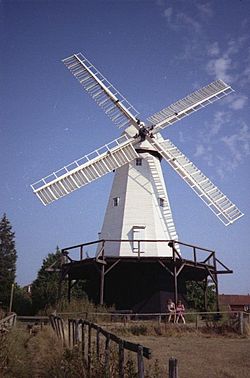Lower Mill, Woodchurch facts for kids
Quick facts for kids Lower Mill, Woodchurch |
|
|---|---|

Lower Mill in 1995
|
|
| Origin | |
| Grid reference | TQ 943 353 |
| Coordinates | 51°5′0″N 0°46′22″E / 51.08333°N 0.77278°E |
| Operator(s) | Kent County Council |
| Year built | 1820 |
| Information | |
| Purpose | Corn mill |
| Type | Smock mill |
| Storeys | Three-storey smock |
| Base storeys | Single-storey base |
| Smock sides | Eight-sided |
| No. of sails | Four |
| Type of sails | Patent sails |
| Windshaft | Cast iron |
| Winding | Fantail |
| Fantail blades | Eight blades |
| No. of pairs of millstones | Three pairs |
| Other information | Mill worked with Spring sails during its commercial life. Fitted with Patent sails on restoration. |
Lower Mill is a special type of windmill called a smock mill. You can find it in Woodchurch, a village in Kent, England. This mill was built a long time ago, in 1820. It's considered a very important old building, known as a Grade II* listed building. This means it's protected because of its history and unique design.
Contents
The Story of Lower Mill
Lower Mill was built in 1820. It was one of two smock mills in the area. The other was called Upper Mill. When it was first built, Lower Mill might have had simple "common sails." Later, around 1848, it might have been updated with "spring sails." These sails were bought by the owner of another type of windmill, a post mill, in Brenzett.
Changes Over Time
The mill's parts were sometimes changed. For example, it used second-hand millstones from other mills. These came from a smock mill in Dymchurch and a post mill in Kennington. The sails on Lower Mill when it stopped working in 1926 had also been used on other mills before. They were first on a post mill in High Halden and then on a smock mill in Aldington.
At one point, a steam engine was added to help power the mill. This was like a backup engine, providing extra power when needed.
Restoration and Repair
In 1946, the mill's owner, Sir Sydney Nicholson, made sure the mill was protected from the weather. He wanted to fix it up more, but he passed away the next year.
Years later, in 1957, people in the village raised money for two new sails. However, the top part of the mill, called the cap, was found to be unsafe. So, the new sails had to be taken off.
By the late 1970s, the mill was in very bad shape and almost falling apart. Luckily, a big project started to fix it. The mill was fully restored and finished in 1986. During this restoration, new "patent sails" were added. These are more advanced sails that can adjust automatically to the wind. A completely new smock tower was also built. In May 2010, a new platform, called a stage, was made and added to the mill.
How Lower Mill Works
Lower Mill is a smock mill with three main levels, or storeys. It sits on a single-storey brick base. The top part, called the cap, is in a special "Kentish-style." The mill turns to face the wind using a fantail. This is a small windmill at the back that automatically moves the cap.
There is a platform, or stage, at the first-floor level. The mill has four "patent sails." These sails are attached to a strong cast-iron rod called a windshaft. Inside, a large gear wheel called the Brake wheel turns a wooden gear called a Wallower. The Wallower is on a wooden Upright Shaft. Another important gear, the Great Spur Wheel, is also still there. The mill used to power three pairs of millstones, which ground grain from above.
Millers of Lower Mill
Here are some of the people who worked as millers at Lower Mill:
- Peter Davis (1820)
- John Parton Sr. (— 1831)
- John Parton Jr. (— 1852)
- W & J Rayner (1852–1867)
- J Tanton (1867 — 1899)
- Albert Tanton (1899–1926)

